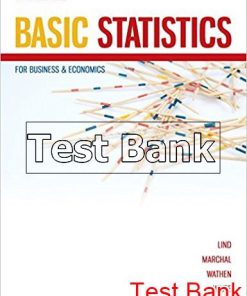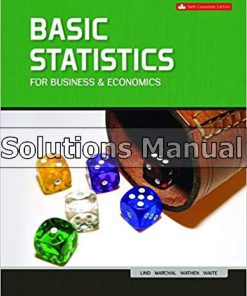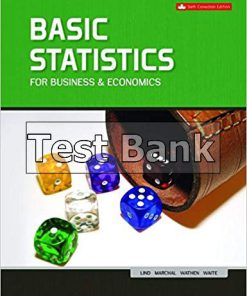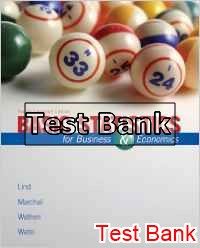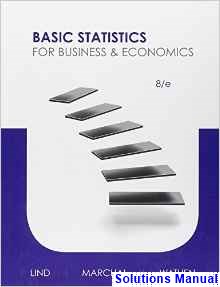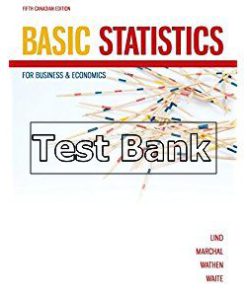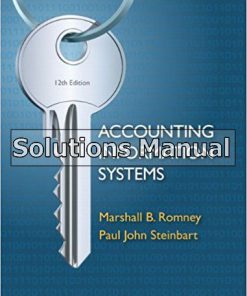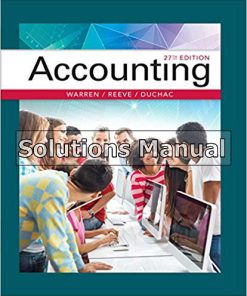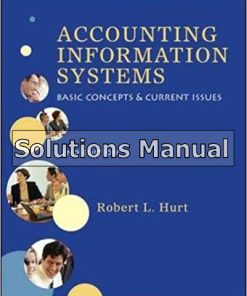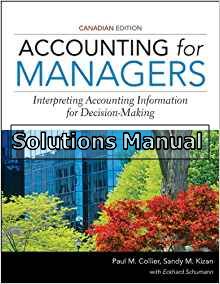Basic Statistics for Business and Economics Canadian 5th Edition Lind Solutions Manual
$26.50$50.00 (-47%)
Basic Statistics for Business and Economics Canadian 5th Edition Lind Solutions Manual.
You may also like
Basic Statistics for Business and Economics Canadian 5th Edition Lind Solutions Manual
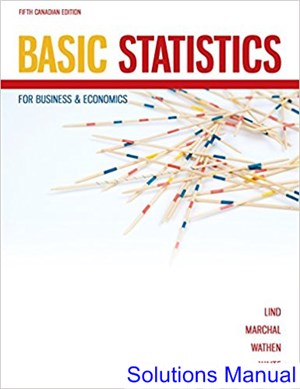
Product details:
- ISBN-10 : 1259103587
- ISBN-13 : 978-1259103582
- Author: Douglas Lind, William Marchal, Samuel Wathen, Carol Ann Waite
Basic Statistics for Business & Economics, Fifth Canadian Edition, provides Canadian business students majoring in economics, finance, marketing, accounting, management, human resource management, and other fields of business administration with an introductory survey of the many business applications of descriptive and inferential statistics.
In today’s business environment, people need the skills to understand numerical information from an increasingly wide variety of sources and then be able to reduce the large amounts of data into meaningful formats in order to interpret, judge and make decisions. Lind 5ce introduces students to these business applications skills, while maintaining a student-oriented learning environment with examples and problems designed to teach the essential knowledge of statistics, in order to prepare them for their careers in business.
Table contents:
Chapter
1 What Is Statistics? 1
Introduction 2
Why Study Statistics? 2
What Is Meant by Statistics? 4
Types of Statistics 6
Descriptive Statistics 6
Inferential Statistics 7
Types of Variables 9
Levels of Measurement 9
Nominal-Level Data 10
Ordinal-Level Data 11
Interval-Level Data 12
Ratio-Level Data 12
Exercises 14
Statistics, Graphics, and Ethics 15
Misleading Statistics 15
Association Does Not Necessarily Imply
Causation 15
Graphs Can Be Misleading 16
Become a Better Consumer and a Better
Producer of Information 17
Ethics 17
Software Applications 18
Chapter Outline 19
Chapter Exercises 19
exercises.com 20
Dataset Exercises 21
Answers to Self-Review 22
Chapter
2 Describing Data: Frequency
Distributions and Graphic
Presentation 23
Introduction 24
Constructing a Frequency Distribution 25
Class Intervals and Class Midpoints 29
A Software Example 29
Relative Frequency Distribution 30
Exercises 31
Graphic Presentation of a Frequency
Distribution 32
Histogram 32
Frequency Polygon 34
Exercises 37
Cumulative Frequency Distributions 38
Exercises 41
Other Graphic Presentations of Data 42
Line Graphs 42
Bar Charts 43
Pie Charts 44
Exercises 46
Chapter Outline 47
Chapter Exercises 48
exercises.com 53
Dataset Exercises 53
Software Commands 54
Answers to Self-Review 56
Chapter
3 Describing Data: Numerical
Measures 57
Introduction 58
The Population Mean 59
The Sample Mean 60
Properties of the Arithmetic Mean 61
Exercises 62
The Weighted Mean 63
Exercises 64
The Median 64
The Mode 65
Exercises 67
Software Solution 68
The Relative Positions of the Mean, Median,
and Mode 68
Exercises 70
The Geometric Mean 71
Exercises 72
Why Study Dispersion? 73
Measures of Dispersion 74
Range 74
Mean Deviation 75
Exercises 76
Variance and Standard Deviation 77
Exercises 79
Software Solution 80
Exercises 81
Interpretation and Uses of the Standard
Deviation 82
Chebyshev?s Theorem 82
The Empirical Rule 83
Exercises 84
Chapter Outline 84
Pronunciation Key 86
Chapter Exercises 86
exercises.com 89
Dataset Exercises 90
Software Commands 90
Answers to Self-Review 92
Chapter
4 Describing Data: Displaying and
Exploring Data 93
Introduction 94
Dot Plots 94
Exercises 96
Quartiles, Deciles, and Percentiles 97
Exercises 100
Box Plots 100
Exercises 102
Skewness 103
Exercises 107
Describing the Relationship between Two
Variables 107
Exercises 110
Chapter Outline 112
Pronunciation Key 112
Chapter Exercises 112
exercises.com 116
Dataset Exercises 116
Software Commands 117
Answers to Self-Review 119
Chapter
5 A Survey of Probability
Concepts 120
Introduction 121
What Is a Probability? 122
Approaches to Assigning Probabilities 124
Classical Probability 124
Empirical Probability 125
Subjective Probability 126
Exercises 127
Some Rules for Computing Probabilities 128
Rules of Addition 128
Exercises 133
Rules of Multiplication 134
Contingency Tables 137
Tree Diagrams 139
Exercises 141
Principles of Counting 142
The Multiplication Formula 142
The Permutation Formula 143
The Combination Formula 145
Exercises 146
Chapter Outline 147
Pronunciation Key 148
Chapter Exercises 148
exercises.com 152
Dataset Exercises 152
Software Commands 153
Answers to Self-Review 154
Chapter
6 Discrete Probability
Distributions 156
Introduction 157
What Is a Probability Distribution? 157
Random Variables 159
Discrete Random Variable 159
Continuous Random Variable 160
The Mean, Variance, and Standard Deviation of
a Probability Distribution 160
Mean 160
Variance and Standard Distribution 161
Exercises 163
Binomial Probability Distribution 164
How Is a Binomial Probability Distribution
Computed 165
Binomial Probability Tables 167
Exercises 170
Cumulative Binomial Probability
Distributions 172
Exercises 173
Poisson Probability Distribution 174
Exercises 177
Chapter Outline 177
Chapter Exercises 178
Dataset Exercises 182
Software Commands 182
Answers to Self-Review 184
Chapter
7 Continuous Probability
Distributions 185
Introduction 186
The Family of Uniform Distributions 186
Exercises 189
The Family of Normal Probability
Distributions 190
The Standard Normal Distribution 193
The Empirical Rule 195
Exercises 196
Finding Areas under the Normal
Curve 197
Exercises 199
Exercises 202
Exercises 204
Chapter Outline 204
Chapter Exercises 205
Dataset Exercises 208
Software Commands 209
Answers to Self-Review 210
Chapter
8 Sampling Methods and the
Central Limit Theorem 211
Introduction 212
Sampling Methods 212
Reasons to Sample 212
Simple Random Sampling 213
Systematic Random Sampling 216
Stratified Random Sampling 216
Cluster Sampling 217
Exercises 218
Sampling ?Error? 220
Sampling Distribution of the Sample
Mean 222
Exercises 225
The Central Limit Theorem 226
Exercises 232
Using the Sampling Distribution of the
Sample Mean 233
Exercises 237
Chapter Outline 237
Pronunciation Key 238
Chapter Exercises 238
exercises.com 242
Dataset Exercises 243
Software Commands 243
Answers to Self-Review 244
Chapter
9 Estimation and Confidence
Intervals 245
Introduction 246
Point Estimates and Confidence Intervals 246
Known _ or a Large Sample 246
A Computer Simulation 251
Exercises 253
Unknown Population Standard Deviation and
a Small Sample 254
Exercises 260
A Confidence Interval for a Proportion 260
Exercises 263
Finite-Population Correction Factor 263
Exercises 264
Choosing an Appropriate Sample Size 265
Exercises 267
Chapter Outline 268
Pronunciation Key 269
Chapter Exercises 269
exercises.com 272
Dataset Exercises 273
Software Commands 273
Answers to Self-Review 275
Chapter
10 One-Sample Tests
of Hypothesis 276
Introduction 277
What Is a Hypothesis? 277
What Is Hypothesis Testing? 278
Five-Step Procedure for Testing a
Hypothesis 278
Step 1: State the Null Hypothesis (H0) and
the Alternate Hypothesis (H1) 278
Step 2: Select a Level of Significance 279
Step 3: Select the Test Statistic 279
Step 4: Formulate the Decision Rule 281
Step 5: Make a Decision 282
One-Tailed and Two-Tailed Tests of
Significance 283
Testing for a Population Mean with a Known
Population Standard Deviation 284
A Two-Tailed Test 284
A One-Tailed Test 288
p-Value in Hypothesis Testing 288
Testing for a Population Mean: Large Sample,
Population Standard Deviation Unknown 290
Exercises 291
Tests Concerning Proportions 292
Exercises 295
Testing for a Population Mean: Small Sample,
Population Standard Deviation Unknown 295
Exercises 300
A Software Solution 301
Exercises 303
Chapter Outline 304
Pronunciation Key 305
Chapter Exercises 305
exercises.com 309
Dataset Exercises 309
Software Commands 310
Answers to Self-Review 311
Chapter
11 Two-Sample Tests
of Hypothesis 312
Introduction 313
Two-Sample Tests of Hypothesis: Independent
Samples 313
Exercises 318
Two-Sample Tests about Proportions 319
Exercises 321
Comparing Population Means with Small
Samples 323
Exercises 326
Two-Sample Tests of Hypothesis: Dependent
Samples 327
Comparing Dependent and Independent
Samples 331
Exercises 333
Chapter Outline 334
Pronunciation Key 335
Chapter Exercises 335
exercises.com 340
Dataset Exercises 341
Software Commands 341
Answers to Self-Review 342
Chapter
12 Analysis of Variance 344
Introduction 345
The F Distribution 345
Comparing Two Population Variances 346
Exercises 349
ANOVA Assumptions 350
The ANOVA Test 352
Exercises 359
Inferences about Pairs of Treatment
Means 360
Exercises 362
Chapter Outline 364
Pronunciation Key 365
Chapter Exercises 365
exercises.com 370
Dataset Exercises 370
Software Commands 371
Answers to Self-Review 373
Chapter
13 Linear Regression
and Correlation 374
Introduction 375
What Is Correlation Analysis? 375
lin83965_fm.qxd 11/9/04 12:24 PM Page xiv
Contents xv
The Coefficient of Correlation 377
The Coefficient of Determination 381
Correlation and Cause 382
Exercises 382
Testing the Significance of the Correlation
Coefficient 384
Exercises 386
Regression Analysis 386
Least Squares Principle 386
Drawing the Line of Regression 389
Exercises 390
The Standard Error of Estimate 392
Assumptions Underlying Linear
Regression 395
Exercises 396
Confidence and Prediction Intervals 396
Exercises 400
More on the Coefficient of Determination 400
Exercises 403
The Relationships among the Coefficient of
Correlation, the Coefficient of Determination,
and the Standard Error of Estimate 403
Transforming Data 405
Exercises 407
Chapter Outline 408
Pronunciation Key 410
Chapter Exercises 410
exercises.com 417
Dataset Exercises 417
Software Commands 418
Answers to Self-Review 420
Chapter
14 Multiple Regression and
Correlation Analysis 421
Introduction 422
Multiple Regression Analysis 422
Inferences in Multiple Linear Regression 423
Exercises 426
Multiple Standard Error of Estimate 428
Assumptions about Multiple Regression and
Correlation 429
The ANOVA Table 430
Exercises 432
Evaluating the Regression Equation 432
Using a Scatter Diagram 432
Correlation Matrix 433
Global Test: Testing the Multiple Regression
Model 434
Evaluating Individual Regression
Coefficients 436
Qualitative Independent Variables 439
Exercises 441
Analysis of Residuals 442
Chapter Outline 447
Pronunciation Key 448
Chapter Exercises 448
exercises.com 459
Dataset Exercises 460
Software Commands 461
Answers to Self-Review 463
Chapter
15 Chi-Square Applications 464
Introduction 464
Goodness-of-Fit Test: Equal Expected
Frequencies 465
Exercises 470
Goodness-of-Fit Test: Unequal Expected
Frequencies 471
Limitations of Chi-Square 473
Exercises 475
Contingency Table Analysis 746
Exercises 450
Chapter Outline 481
Pronunciation Key 481
Chapter Exercises 482
exercises.com 484
Dataset Exercises 485
Software Commands 486
Answers to Self-Review 487
CD Chapters
? Statistical Quality Control
? Time Series and Forecasting
Appendixes
Appendixes A?I Tables
Binomial Probability Distribution 489
Critical Values of Chi-Square 494
Poisson Distribution 495
Areas under the Normal Curve 496
Table of Random Numbers 497
Student?s t Distribution 498
Critical Values of the F Distribution 499
Wilcoxon T Values 501
Factors for Control Charts 502
Appendixes J?N Datasets
Real Estate 503
Major League Baseball 506
Wages and Wage Earners 508
CIA International Economic and
Demographic Data 512
Whitner Autoplex 515
Appendix O
Getting Started with Megastat 516
Appendix P
Visual Statistics 520
Answers to Odd-Numbered Exercises 525
Photo Credits 552
Index 553
People also search:
basic statistics for business and economics canadian 5th
basic statistics for business and economics 8th edition
basic statistics for business and economics 6th canadian edition
basic statistics for business and economics 10th edition
statistics for business and economics chapter 1

